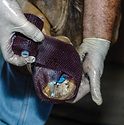Advertise Follow Us
American Farriers Journal

View Archived Issues
September/October 2015
Volume: 41
Edition: 6
American Farriers Journal is the “hands-on” magazine for professional farriers, equine veterinarians and horse care product and service buyers.
-
Table Of Contents
Table Of Contents
Shoeing for a LivingStaying One Step Ahead
Preparing for volatile changes in seasonal climates pays off with better feet for Oklahoma farrierRead MoreLabor Law Shift Could Change Your Business
Some farriers at risk of losing their independent contractor statusRead MoreAluminum Stock And A Rasp Make A New Forging Challenge
The 2016 Summit Mail-In Forging Competition requires making an aluminum shoe with a steel bar made from a raspRead MoreThe first in a series of articles about licensing, standards and ownership of the farriery tradeAre Farriers Losing Control of the Footcare Game?
Some industry leaders believe it’s time to establish hoof-care quality and control standards before someone else doesRead MoreCelebrating 40 Remarkable Years
Equine footcare has seen many significant changes over the past 4 decadesRead MoreAn Ever Evolving Industry
The past 40 years of farriery have witnessed important changes in the business practices of the tradeRead MoreCasting As An Option In The Farrier’s Toolbox
Practitioners believe that poor practices can lead to some farriers’ misunderstandings and misgivings about the modalityRead MoreFlip-Flops Gaining Foothold In Show World
New York farrier shares some advantages and disadvantages of the padRead MoreImprove Your Efficiency and Productivity
Save time, energy and money with these must-have productsRead MoreEducating Clients on the Arthritic Horse
New owners may not be aware of what can be done for a stiff and sore animalRead MoreSpotlight On Footcare: Colorado Classic Gives Everyone A Chance To Participate
Farriers of all experience levels gathered to test their forging skills and stay sharp at the anvilRead More -
Featured Articles
Featured Articles
Shoeing for a LivingStaying One Step Ahead
Preparing for volatile changes in seasonal climates pays off with better feet for Oklahoma farrierRead MoreAn Ever Evolving Industry
The past 40 years of farriery have witnessed important changes in the business practices of the tradeRead More - Digital Edition
-
Online Extras
Online Extras
















